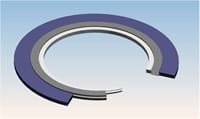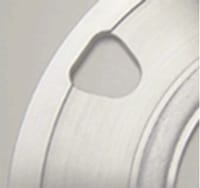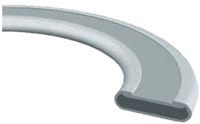A gasket is a mechanical seal between to mating surfaces. Its purpose is to prevent leakage of liquids or gasses flowing or contained within the assembled parts. The gasket is placed between the parts to be assembled, and it is compressed when those parts are bolted together. A common example is the cylinder head gasket in a car engine, which is shown in Fig 1.
Fig 1: A Cylinder Head Gasket from a Car Engine
Gaskets compensate for lack of conformity of mating surfaces. Therefore, they are made from ductile or compressible materials that can fill any irregularities on those surfaces. They are usually punched from sheet materials such as gasket paper, rubber, silicone, soft metal, cork, felt, or plastic. Gaskets differ from seals, which are formed individually in their own configuration.
Important parameters for gaskets and gasket materials include thickness, density, fluid compatibility, stress relaxation, compressibility, and recovery. Generally, one should use the thinnest possible gasket for an application. The thicker the gasket, the greater the settling of the gasket, and settling can result in loss of fastener load. High temperatures and pressure fluctuations can also induce settling. Some gaskets require sealant, such as silicone grease, to function properly. Hard and thin gaskets can be held to closer tolerances than soft and thick ones.
During assembly, bolts must be tightened sufficiently to create intimate contact between the gasket and joint surfaces. Non-uniform tightening can result in leakage. The load on the gasket must be properly selected to assure that the gasket will seal properly. The gasket must compress sufficiently to seat into the irregularities of the mating surfaces. The bolt stress upon the gasket must also overcome hydrostatic forces generated by internal fluid or gas pressure as well as torque and vibrations encountered during normal usage.
A normal installation practice is to evenly torque each of the bolts in the assembly because the load on the gasket cannot be directly measured. However, Fujifilm Prescale® pressure indicating film can be used to determine the actual pressure exerted against the gasket.
Fujifilm Prescale® is a unique, affordable, and easy to use tool that reveals the distribution and magnitude of pressure between any two contacting or mating surfaces. Fujifilm Prescale® is a mylar-based film that contains a layer of tiny microcapsules. The application of force upon the film causes the microcapsules to rupture, producing an instantaneous and permanent high resolution “topographical” image of pressure variation across the contact area.
Simply place Fujifilm Prescale® pressure indicating sensor film between any two surfaces that touch, mate or impact. Apply pressure, remove it, and immediately the film reveals the pressure distribution profile that occurred between the two surfaces. Conceptually similar to Litmus paper, the color intensity of Fujifilm Prescale® is directly related to the amount of pressure applied to it. The film’s color intensity increases as the pressure increases. Figure 2 shows the use of Fujifilm Prescale® to measure pressure on an engine head gasket.
Fig 2: Example Usage of Fujifilm Prescale® Film Placed Across an Engine Head Gasket
Fujifilm Prescale® is extremely thin (4 to 8 mils) which enables it to conform to curved surfaces. It is ideal for invasive intolerant environments and tight spaces not accessible to conventional electronic transducers.
Used in conjunction with Fujifilm Prescale® pressure indicating films, Topaq® provides a quick, yet thorough analysis of the pressure distribution and magnitude between any two surfaces that come into contact. This Windows®-based system renders high resolution, color-calibrated images that accurately reflect how force is dispersed in an application. The system consists of a specially calibrated scanner and the Topaq® software. Figures 3 and 4 show Fujifilm Prescale® film before and after Topaq® analysis.
 |  |
| Fig 3: Fujifilm Prescale® Film Before Topaq® Analysis | Fig 4: Fujifilm Prescale® Film After Topaq® Analysis |
Fujifilm Prescale® pressure indicating film is also a valuable tool for researchers. An experimental study of thermal contact resistance was conducted with metallic contacts across bolted joints. (“Thermal Contact Resistance Correlation for Metals across Bolted Joints”, C. L. Yeh and C. T. Lin, Int. Comm. Heat Mass Transfer, Vol. 30, No. 7, pp.987-996,2003) In this study, the contact pressure of bolted interfaces was measured by Fujifilm Prescale®. The researchers established correlations between interfacial pressure to torque and to bolt-related parameters. These correlations were verified by the Fujifilm Prescale® data.
Four basic conditions should be considered when choosing a gasket material: operating conditions, chemical compatibility, design of the assembly, and the external environment. Gaskets and seating surfaces should be inspected prior to assembly. Bolt contact areas and nuts should be lubricated. At this stage, Fujifilm Prescale® can be used to determine the pressure profile on the gasket. The bolts and nuts should be loosely installed. Select a bolting sequence and number bolts accordingly. Begin tightening the all the bolts to a low torque value. Then increase the torque in stages until full torque is reached. If Fujifilm Prescale® was used, as described above, remove the bolts and mating parts, analyze the Fujifilm Prescale®, and per the above procedure, reassemble without the pressure indicating film. Prior to placing the assembly in service, torque the bolts again as needed to compensate for gasket relaxation.
There are six basic types of gaskets. Gaskets made from compressible materials, like rubber sheet gaskets, have the lowest cost. The other gasket types are designed for specific operating conditions and are costlier. Figures 5–10 show the various gasket types.
 |  |
| Fig 5: Rubber Sheet Gaskets from IndiaMart.com | Fig 6: Solid Metal Gasket from Shield Sealing.com |
 |  |
| Fig 7: Spiral Wound Gasket from Tecson.com.cn | Fig 8: Constant Sealing Stress Gasket from JJENCO.com |
 |  |
| Fig 9: Double-jacketed Gasket from UtilityEngineers.net | Fig 10: Kammprofile Gasket from Kazseal.com |
Solid metal gaskets are machined in a variety of shapes. They are designed for high-pressure, high-temperature, or highly corrosive applications.
Spiral wound gaskets are semi-metallic (i.e., a mixture of metal and compressible material), and they are designed for high-pressure and high-temperature applications.
Constant seating stress gaskets consist of a solid carrier ring (such as stainless steel) and two elements of a compressible material installed within two opposing channels, one channel on either side of the carrier ring. These gaskets rely upon a degree of flange rotation; do not need elaborate torque procedures; provide uniform radial seating stress across the entire sealing surface; are self-aligning; cannot be over- or under-tightened or tightened unevenly; are unaffected by usual tooling or assembly considerations; are immune to common causes of leakage; and are refurbishable.
Double-jacketed gaskets are particularly suited for applications like heat exchangers and boilers. The gasket is constructed of a soft, heat resistant, non-asbestos filler material, which is completely enclosed in a two-piece metal jacket.
The Kammprofile gasket consists of a solid metal core, serrated on both sides and covered with a soft, conforming, sealing material that is bonded to each face. This gasket is especially well suited for use in heat exchangers and other large diameter applications where a rigid, semi-metallic design, is desired for blowout resistance and ease of installation.
Regardless of the gasket chosen for any application, Fujifilm Prescale® is a valuable tool for evaluating the pressure profile at the gasket interface. Fujifilm Prescale® aids in establishing installation torque requirements and other design considerations. It is also a valuable research tool.


